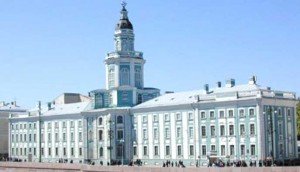Founded in 1714, the Museum of Natural History was transferred to this building in 1727. The building of the Kunstkamera, where the museum came to be housed, was erected in 1718— 1734 by the architects G. I. Mattarnovi, G. Kiaveri and M. G. Zemtsov. In the 1740’s the structure was remodelled under the supervision of S. I. Chevakinsky. The present-day Museum of Anthropology and Ethnography has to a considerable degree completed the collection of rarities in Peter’s Kunstkamera. It also contains the priceless papers of the famous Russian explorers N. N. Miklukho-Maklai, Y. F. Lisyansky and others. The exhibition of the museum is devoted to the People’s Democracies of the East and the culture and life of the peoples of India, Indonesia, North and South Americas, Africa and Asia.
In the Kunstkamera — the cradle of Russian science — M. V. Lomonosov worked from 1741 to 1765. In 1947, in the only remaining building’ associated with the life of the great scientist, a museum was established. The instruments and various preparations of that time, mosaics and geographical maps, as well as the historical and literary works by M. V. Lomonosov, are displayed here.
Museum of Anthropology and Ethnography; M. V. Lomonosov Museum of the Academy of Sciences of the Russia: Vasilyevsky Ostrov, Universitetskaya Naberezhnaya, 3.
You are here:
- Home
- Architecture
- Saint Petersburg
- Museum of Anthropology and Ethnography;…






